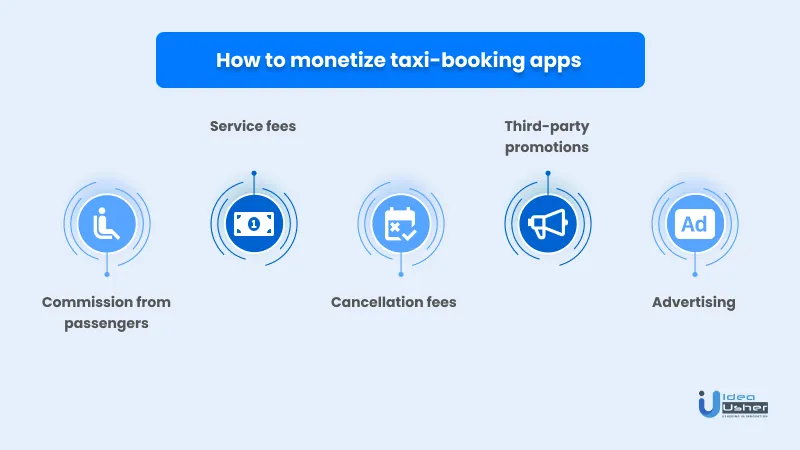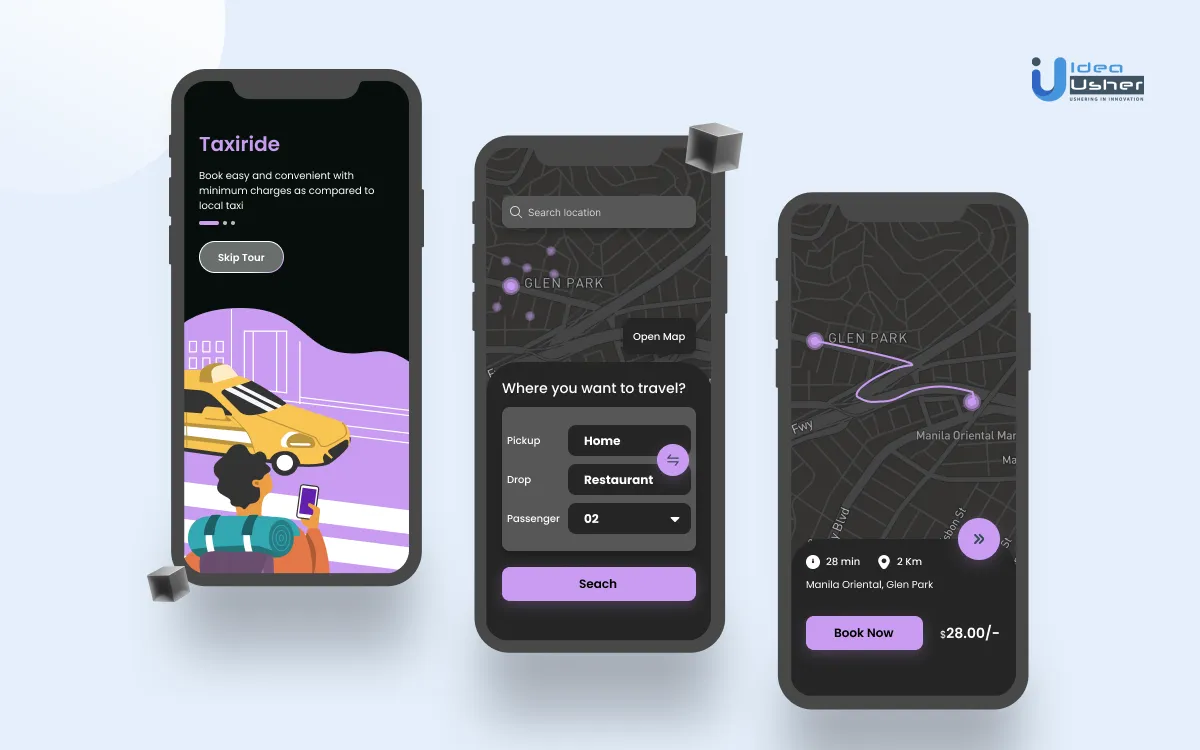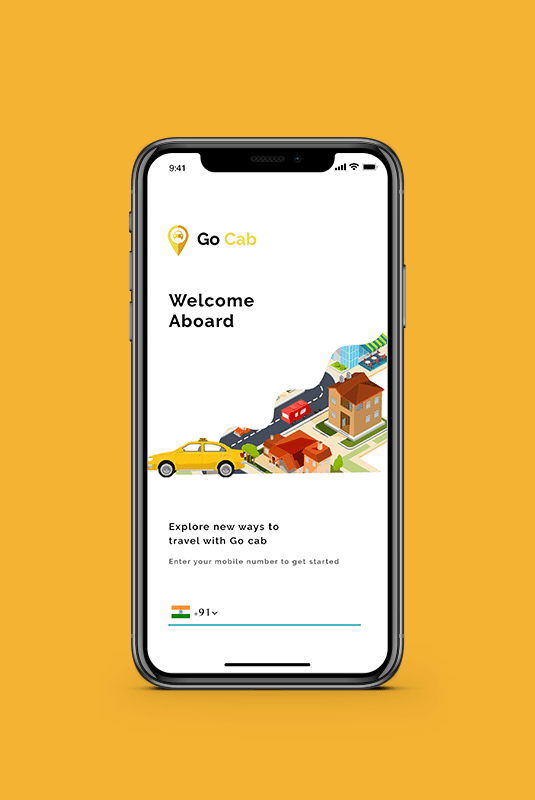Entrepreneurs are going for app development to expand their business. Be it from food delivery to hotels booking. Each industry preferred having apps for their business.
Like many businesses, the cab booking business has also become very profitable. Look at this Statistica report; it predicts that the taxi booking business will reach $126,521 million by 2025.
Don’t you think it is the right time to enter the cab booking business by doing taxi app development? But, what are the steps and requirements to develop a mobile app for the cab booking business? You can learn it in the next section.
Detailed process of taxi app development
Learn how to create a taxi booking app that helps app users to search and book nearby cabs! Also, you can learn the development process in detail from this blog.
Step 1: Decide your goals in building a taxi booking app
There are many business options in the taxi booking app. You can develop apps for customers or businesses. These are the following app development options:
- Carpooling app
- Car rental service
- Shuttle service app
- Bus booking
- Trucking & logistic solutions
- Bike-sharing
- On-demand delivery app
- Employee transportation app
Also, you can integrate your app into existing taxi businesses to provide a digital platform for users.
Step 2: Understand the market situation
Once you decide on your app development goals, do a competitor analysis and a detailed study about targeting the market.
Based on market analysis, you can determine the future planning of the app development process.
These are some of the top-performing brands in the cab booking business who did market analysis just right:

1. Uber
This app is available in 630+ cities worldwide. It has a fleet that consists of UberPool, UberX, UberGo, UberBlack, helicopters (in Dubai, New York), and more.
| Founded | 2009 |
| Platform | Android & iOS |
| Ratings | 4.1 |
| Downloads | 500M |
| Revenue | 17.44B |
2. Lyft
Lyft is considered a direct competitor of Uber. It operates in 200+ cities in the US market. Lyft is considered to be cheaper than Uber. At the initial start, Lyft was operating under the name Zimride.
| Founded | 2012 |
| Platform | Android & iOS |
| Ratings | 3.7 |
| Downloads | 10M |
| Revenue | 3.2B |
3. Curb
In Curb, there are 3 options for ride-booking: ride now, ride later, and
pair and play. Curb has over 50K taxis in 65 cities in the US.
| Founded | 2007 |
| Platform | Android & iOS |
| Ratings | 2.7 |
| Downloads | 1M |
| Revenue | 10.7M |
4. Grab
Grab is a popular brand in South Asian countries such as Singapore, Philippines, Malaysia, Indonesia, Thailand, and Vietnam. It provides a wide range of payment options for its customers. It provides different services to its users like GrabTaxi, GrabShare, GrabHitch, GrabBike, and GrabFamily.
| Founded | 2012 |
| Platform | Android & iOS |
| Ratings | 4.3 |
| Downloads | 100K |
| Revenue | 122M |
5. DiDi-Rider
DiDi is a china based cab booking provider. It operates in over 400 cities having 500 million registered users. Didi provides a wide range of services such as Express, Premier, Luxe, Bus, Designated Driving, Enterprise Solutions, Bike Sharing, E-bike Sharing, and car rental and food delivery.
| Founded | 2012 |
| Platform | Android & iOS |
| Ratings | 4.3 |
| Downloads | 50M |
| Revenue | 837M |
Step 3: Develop a taxi app technical feasibility documentation.
Technical documentation tells app developers about app development requirements. It may include all listed features and services that you want in your taxi booking app.
The document also includes information about existing technologies that can be applied to the project and outlines the steps needed to implement new technology. It also evaluates hardware and software requirements, as well as constraints.
Technical feasibility must be assessed if you want to:
- Alter a product or service,
- Deploy new technology,
- Introduce new processes or procedures,
- Change project requirements
Step 4: Find software/app developers
A strong developer team is one of the most important parts of building a great app. The project manager and designer define the scope for what is technically feasible and what will be included in the final product. Developers then execute that vision using code and bring it to life as a working mobile or web application.
Step 5: Choosing UI/UX.
During this process, you’ll gather requirements, do some pre-design work like story-boarding, create low-fidelity prototypes, and then create high-fidelity prototypes that can be shown to stakeholders. Then you test them to make sure they’re correct. Also, you can check top-free wireframing tools for stunning UI/UX designs.
Step 6: The backend development process
The backend development process is the part of the software development process that is responsible for making sure that the front-end and user-facing parts of the application are working correctly and that they are speaking to the database.
Backend developers work closely with front-end developers to make sure that the data being displayed is correct and that it displays correctly, as well as to make sure that any data submitted or entered by users gets stored correctly in a database.
Backend development is also responsible for making sure that all of the interactions between databases, servers, APIs, and other pieces of software are handled correctly.
Step 7:Testing the application.
Testing is the process of evaluating a system or its component(s) with the intent to find whether it satisfies the specified requirements or not. In simple words, testing is executing a system in order to identify any gaps, errors, or missing requirements contrary to the actual requirements.
Step 8: App launching on the targeted platform.
Your app is now ready for launch. The developer team will publish it on your preferred app platform. You can write details and can include some screenshots of apps highlighting features. This will help users know about your app, increasing the chance of getting more app downloads.
Step 9: App promotion/ marketing
You can promote the app on social media and other platforms to get more app downloads. It is better to research your audience and mark some common platforms where they are most active.
Step 10: Product improvement/ maintenance
App maintenance is basically like lawn care. If you don’t water your lawn, then it will start to die. A similar thing can happen with an app.
If your app isn’t maintained, then it will start to break down for users and eventually stop being functional. It’s also important to update the look of an app every once in a while to keep people interested.
Challenges in taxi app development
Developing a taxi booking app has many challenges that can be solved by finding its solutions. These are some of the common challenges which are discussed as follows:
1. Competing against app competitors
It’s almost impossible to compete well against giants such as Ola & Uber. Instead of targeting their customers, you can focus on specific audience categories.
For example, you can offer female-only cab booking services, provide exclusive commute services for office employees, etc.
2. Building app community
It’s not easy for new brands to bring sellers and buyers on their platforms. To attract an audience, you may need to gather both taxi drivers and car owners to put their cars for rent. You can read the chicken and egg problem blog to bring taxi riders and taxi owners to your app.
3. Adjusting with the local community
Markets in different regions have different demands and requirements. You can do market research on all areas where you want to expand your cab booking app business.
4. Dealing with system loads
Once the user base grows in your app, you may have to deal with the overloading of data. Also, it’s almost certain that the system won’t handle the load. It can result in a slow performance which might disturb the smooth user experience of app users.
A better solution for this situation would be to upgrade your server plan and purchase additional data storage to store more user data.
Essential features for taxi app development
A taxi app consists of two major audience parts: the driver and passenger apps. At the same time, the app owners will access an admin panel to manage business operations.
You can check some standard features of the taxi booking app in three separate parts:
A. Passenger app features
1. Login and signup: The user can log in to the app with an email and SMS verification code sent to the user’s phone number. You can also ask for user personal details such as name, contact details, etc.
2. Passenger profile: Users can make their profile in your app and have access to edit their profile, such as changing photos or other details.
3. Payment methods: You can allow popular payment options in your app for booking taxis. More extended options for payments will provide a better experience for app users to book cabs in their preferred payment method.
4. Define user location: App will ask user permission to allow their location access to your app. It will help taxis to reach passenger’s locations.
5. Request a taxi: This will allow the passenger to place a taxi request and set the destination point. Also, Passengers can check the ride cost and can modify the route.
6. The matching: App will match passengers’ location with nearby drivers.
7. Browse driver list: The app will show a list of drivers with detailed info about cars and reviews.
8. Trip awaiting: This feature comes with a countdown feature that tells about when the driver will arrive by tracking their position, and the user can cancel the ride.
9. Online payment: It will allow passengers to pay through online methods such as debit/credit cards or an integrated third-party payment gateway.
10. Notification: This sends push notifications on the passenger’s device to inform about many updates, such as approval of booking requests. The driver is nearby; the app has charged money, the driver canceled the bid, etc.
B. Driver app features
1. Login and signup: It will allow drivers to log in to the app by providing their phone number and receiving an SMS with a verification code. The driver may also need to provide information about car registration and bank account details.
2. Driver profile: Drivers can add personal information such as name, phone number, car details, etc., and allow the driver to edit it.
3. Geolocation: It helps the driver to navigate the passenger’s location with built-in street navigation by Google Map API.
4. Rides: Drivers can see search parameters and a list with detailed information about the requests.
5. Trip request confirmation: This feature will allow drivers to confirm the trip, wait for passenger confirmation, and cancel the request.
6. Trip: It gives information about the passenger approval of the ride. It notifies the passenger that the driver has arrived. It also provides the time history of when the ride started and ended.
C. Dispatch panel features
1. Login and profile: It allows an admin to register in the platform, set the profile, and change the password.
2. Admin roles: Admin can provide different types of access to the other administrators.
3. Cars: It lets admins edit the list of vehicles and their details.
4. Ratings: This feature allows viewing and editing the rating of drivers.
5. Rides: Admins can view the list of rides and ride details.
6. Payments: This shows the list of transaction info such as user payment history and the total rides.
7. Drivers: It allows adding, editing, and deleting a list of drivers and their information.
Benefits of Taxi Booking App Development
Benefits for drivers:
- Increased efficiency – they can receive more ride requests and complete more trips in less time
- Increased earnings potential – they can work more flexible hours and take advantage of surge pricing during peak hours
- Improved safety – the app can provide driver verification and tracking, as well as record trip details for accountability and security purposes
Benefits for passengers:
- Improved accessibility – people with disabilities or limited mobility can easily book rides and receive assistance as needed
- Reduced environmental impact – ride-sharing can help reduce traffic congestion and lower carbon emissions
- Enhanced customer experience – passengers can rate their driver and provide feedback to help improve the overall quality of the service
- Added convenience – passengers can use the app to pre-book rides for future dates and times, making planning and scheduling easier.
Overall, taxi booking app development has the potential to revolutionize the transportation industry by providing more efficient, convenient, and accessible services to both drivers and passengers.
How to monetize taxi-booking apps?
You can apply the following monetization methods to turn a taxi booking application into a money-making business.

1. Commission from passengers: You can make money by charging passengers a service commission fee between 20-25% of the total ride cost.
2. Service fees: This option will let you charge passengers a flat booking rate and additional service fees for security, service, and payment processing.
3. Cancellation fees: This type of payment can serve as a penalty if the passenger cancels a ride.
4. Third-party promotions: You can make money from promotional collaboration with famous brands like Oyo, Pepsi, and Spotify.
5. Advertising: Advertisements in your booking taxi app can also serve as a better option; you can charge based on cost-per-click or cost-per-impression.
Also, you can check other app monetization methods.
Some pitfalls to avoid when developing taxi apps
You can avoid some common mistakes while developing a cab booking app. Knowing common mistakes in advance will help you avoid unnecessary problems while developing taxi booking apps.
1. Simultaneously building for multiple platforms
App publishing on multiple platforms simultaneously can involve extra costs in developing apps. You may research the most suitable platform for your app. After publishing and getting a better user response, you can scale your app on other platforms.
2. Mismanaging app project
Most entrepreneurs lack project management experience in developing apps. Sometimes it can cost their time, effort, and money. Therefore, you may always need to hire a reputed, experienced app developer for your project.
3. Delay In marketing your app
Once your taxi booking app gets published, you may need to focus on promotional activities. You can contact marketing agencies or pitch to your app niche’s relevant blog websites for writing articles around your app and explaining its benefits and features.
Conclusion
People are adopting digital transformation in the fastest way. Most entrepreneurs take advantage of this situation by providing apps in many business categories. Taxi booking apps are also one of the best profitable businesses. If you also want to develop a taxi booking app for your business, contact Idea Usher.
Build Better Solutions With Idea Usher
Professionals
Projects
Frequently Asked Questions
Check some of the common FAQs to help resolve your doubts. You can contact our team if you are still facing any doubts.
Q. What is the prediction of the global market size of taxi apps?
A. The global market size of taxi booking is expected to reach around $26B in 2021. It shows that the competition in the ride-sharing domain will only increase in these countries.
Q. How to start a new taxi-booking business successfully?
A. You can start a business by defining the exact target audience app purpose and finalizing a business plan. You must plan the budget for app development and promotion.
Q. How much time is needed to create a basic version of the taxi app?
A. It can take approximately 4-6 months to develop the first version of a taxi app operating on a single platform (iOS or Android), including client and rider app development, backend development, and a basic admin panel. Developing a fully-fledged taxi-hailing system may need additional months.













